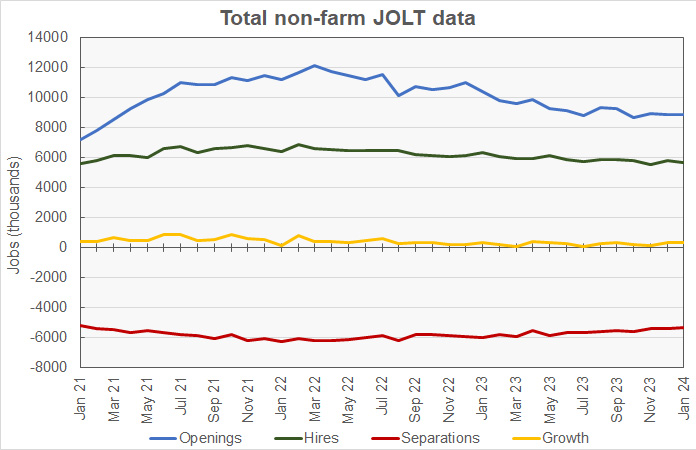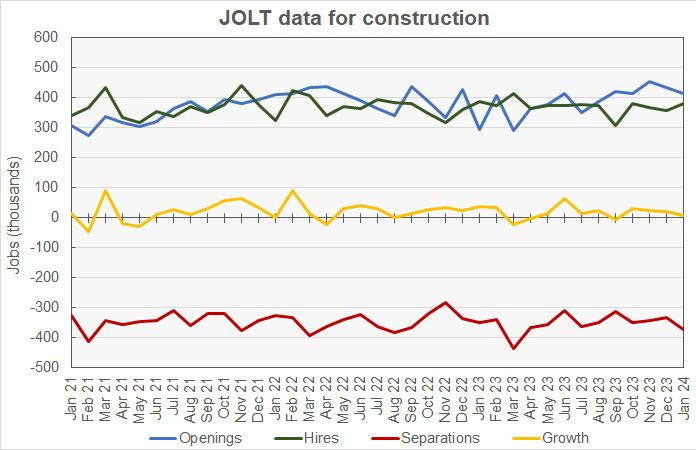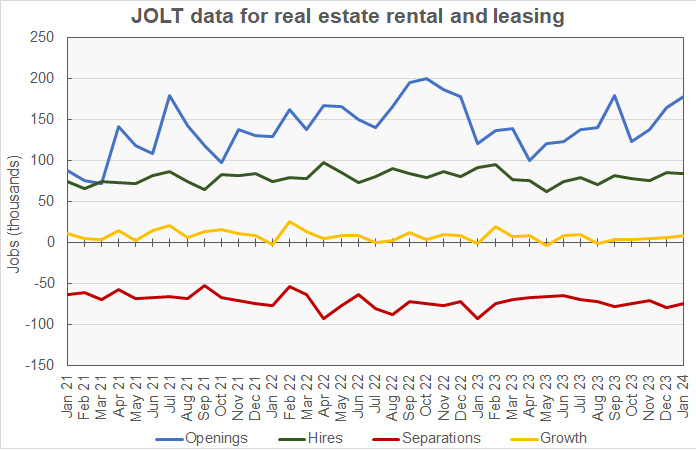The Job Openings and Labor Turnover (JOLT) report from the Bureau of Labor Statistics (BLS) said that the number of job openings in January was 8.86 million. This was reported to be down 26,000 openings month-over-month. In addition, the openings figure for December was revised lower by 137,000 openings. Job openings were down 1,562,000 from the year-ago level.
Note that this JOLT release uses new employment estimates and new seasonal adjustment factors. Therefore, revisions to prior month’s data may be larger than usual in this month’s report and these revisions may extend back to January 2019.
Hiring was down from last month’s revised (+166,000) figure for the economy as a whole, falling 100,000 to a level of 5.69 million hires. Total separations fell 74,000 from last month’s revised (+54,000) figure to a level of 5.34 million. Within total separations, quits were reported to fall 1.6 percent while the layoffs rate fell 2.2 percent. Quits represented 63.4 percent of total separations for the month.
Overall hiring slows
For a discussion of the JOLT report and how it relates to the Employment Situation Report, please see the paragraph at the end of this article.
The January job openings figure represents 5.3 percent of total employment plus job openings. For comparison, the unemployment rate in January was reported to be 3.7 percent and 6.12 million people were unemployed. Another 5.80 million people said that they would like a job but were not counted as being in the labor force since they were not actively seeking employment.
The excess of hiring over separations in the January JOLT report implies an employment increase of 346,000 jobs for the month. Last month’s employment increase was revised to 368,000 jobs, up by 112,000 jobs from the gain reported last month.
Of those leaving their jobs in January, 3.39 million quit voluntarily, while 1.57 million people were involuntarily separated from their jobs. The remainder of people leaving their jobs left for other reasons, such as retirements or transfers. The portion of people quitting their jobs was down 0.1 percentage point from last month’s figure at 2.1 percent of the labor force. The involuntary separations rate was unchanged from last month’s revised figure at 1.0 percent.
Total non-farm JOLT data for the last 37 months is shown in the first chart, below. It shows that all three major labor market metrics, job openings, hires and separations, have been trending lower for the last two years.

Construction employment higher despite fall in openings
The next chart, below, shows the employment situation for the construction jobs market over the last 37 months. It shows that January saw a net gain of 8,000 construction jobs compared to last month’s revised gain of 22,000 jobs.

Construction jobs openings in January were reported to be 413,000 jobs, 41 percent higher than last year’s unusually low level. On a month-over-month basis, openings for construction jobs were reported to fall by 21,000 openings from December’s revised (-15,000) job openings figure. Job openings in the construction category represent 4.8 percent of total employment plus job openings, down from the 5.3 percent level reported last month.
Hiring was reported to be up by 23,000 jobs in January from the prior month’s revised (-11,000) jobs figure at 380,000 new hires. The number of construction jobs that were filled in January was reported to be down 1.6 percent year-over-year.
Construction jobs total separations were reported to rise by 37,000 jobs from the prior month’s revised (-6,000) figure to 372,000 jobs.
Quits were reported to fall by 1,000 jobs from December’s revised (-1,000) figure at a level of 148,000 jobs. Quits represented 39.8 percent of separations for the month, down by 4.7 percentage points from the revised level of last month and well below the level for the economy as a whole.
Layoffs were reported to rise by 37,000 from December’s revised (+4,000) figure to 210,000 jobs. “Other separations” which includes retirements and transfers, were reported to be down 14,000 at 8,000 jobs.
RERL hiring and separations both lower
The last chart, below, shows the employment situation for the real estate and rental and leasing (RERL) jobs category. Employment in this jobs category was reported to rise by 9,000 jobs in January.

The number of job openings in the RERL category was reported to be 178,000 jobs at the end of January. This was up 13,000 job openings from the revised (+11,000) level of the month before. Job openings in January were 47.1 percent higher than the year-earlier level. Job openings in the RERL category represent 6.6 percent of total employment plus job openings.
Hiring in January was down by 2,000 jobs from December’s revised (+2,000) figure at 84,000 jobs. The hiring figure was 8.7 percent below the year-earlier level.
Total separations in the RERL jobs category in January were down by 5,000 from December’s revised (-2,000) figure at 82,000 jobs.
Quits were down by 16,000 from December’s unchanged figure at 36,000 jobs. Quits represented 48 percent of total separations in January, the lowest level since the pandemic-marred summer of 2020. Layoffs were reported to rise by 15,000 from December’s revised (-2,000) figure to 37,000 jobs.
The numbers given in the JOLT report are seasonally adjusted and are subject to revision. It is common for adjustments to be made in subsequent reports, particularly to the data for the most recent month. The full current JOLT report can be found here.
Comparing the reports
The US labor market is very dynamic with many people changing jobs in any given month. The JOLT report documents this dynamism by providing details about job openings, hiring and separations. However, it does not break down the jobs market into as fine categories as does the Employment Situation Report, which provides data on total employment and unemployment. For example, while the Employment Situation Report separates residential construction from other construction employment, the JOLT report does not. The Employment Situation Report separates residential property managers from other types of real estate and rental and leasing professionals, but the JOLT report does not. However, the JOLT report provides a look at what is driving the employment gains (or losses) in broad employment categories.










